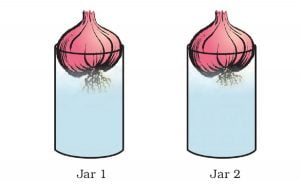Table of Contents
Tissues Activity Solution Class 9 Std Science Book Chapter 6
Activities:
6.1: Activity to demonstrate the growth of plants occurs in certain regions only.
Activity 6.1 Class 9 Science Chapter 6 Tissues

Observation: Removal of the root tip stops the root growth.
Explanation:
Growth in plants occurs in specific regions. These regions are apical, lateral and intercalary. These regions contain fast-dividing cell groups called meristematic tissues. When we cut the onion root tip, the apical meristem tissues are cut off. The apical meristem is the main dividing tissue in the root and shoot which increases the length. As a result, the growth of root is stopped in these roots.
Inference: Here we see the root grows only at the tip. It indicates that part of a plant grows only at specific places. If we observe all parts of a plant we see, root tip cause root elongation, shoot tip cause shoot elongation, lateral sides of the stem and root increase the thickness of root and stem. Similarly, lateral sides of leaf grow and make a leaf big.
Activity 6.2 Class 9 Science Chapter 6 Tissues
Activity 6.2 asks us to observe the cross-section of the stem of a plant under the microscope.
Observation: We see different types of cells in the crosssections.
Explanation: A plant consists of different types of tissue. When we put them on the microscopic slide, we can easily see them and distinguish them from each other. Various types of cells are:
a. Parenchyma: These are hexagonal flat loosely packed cells which store food. If they contain chlorophyll, we call them chlorenchyma. In aquatic plants, they contain big vacuoles to provide buoyancy. We call them aerenchyma.
b. Collenchyma: These are elongated, irregularly thickened cells with low intercellular spaces. They provide support to the plant. e.g. tendril and stem of a climber.
c. Sclerenchyma: These are elongated, thickened cells with lignified walls and no intercellular spaces. They are dead cells and provide strength and protection to the plant. e.g. Coir of coconut.
B. Complex permanent tissues:
These tissues contain different types of cells combined to form a specific function.
a. Xylem: These are water-conducting tissues of a plant. They consist of xylem fibres, tracheid, vessels and xylem parenchyma cells. Tracheids and vessels have a tubular structure to conduct water while xylem fibres provide support and parenchyma stores food.
b. Phloem: Phloem is food conducting tissues. They consist of sieve cells, sieve tubes, companion cells, phloem fibres and phloem parenchyma cells. Food passes through long conductive tubes: sieve cells and sieve tubes. Companion cells assist them in the transport while fibre cells provide support and parenchyma provide food.
Note: All fibrous cells are dead cell and serve only supportive and protective purposes.
Activity 6.3
Activity 6.3 asks us to peel Rhoeo leaf and observe it under the microscope.
Observation: We see flat epidermal cells and a few stomatal cells.
Animal tissue Class 9 Science Activity solution
Activity 6.4
Activity 6.4 asks us to observe blood cells under the microscope.
Observation: We see various types of blood cells, platelets, and plasma under the microscope. Various blood cells are:
a. Red blood corpuscles: These are round cells with a concavity on the surfaces. They transport glucose and gases. The red colour is due to the pigment haemoglobin.
b. White Blood Corpuscles:
Activity 6.5
Answer:
Next: Tissues Question Answer Solution.
Tissues MCQ/objective questions.
Ref: Chapter 5 Class 9 science NCERT.
Give me answer for activity 6.4
in class 9 chapter 6
Can i have the observation of the activity 6.1 of chapter6 class 9??
Activity 6.5 answers
Give me answers for activity 6.5 in class 9 chapter 6 immediately